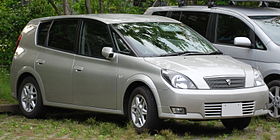Toyota Opa
| Toyota Opa | |
|---|---|

2000 Toyota Opa
|
|
| Overview | |
| Production | 2000-2005 |
| Body and chassis | |
| Body style | 5-door CUV |
| Layout | Front engine, front-wheel drive / Four-wheel drive |
| Powertrain | |
| Engine | 1.8 L I4 1ZZ-FE 2.0 L I4 1AZ-FSE |
| Dimensions | |
| Length | 4,250 mm (167 in) |
| Width | 1,695 mm (66.7 in) |
| Height | 1,525 mm (60.0 in) |
| Curb weight | 1,310 kg (2,890 lb) |
| Chronology | |
| Successor | Toyota Mark X ZiO |
The Toyota Opa was an automobile, produced by Toyota from 2000 to 2005.
The Opa was the result of the V50 series Vista Ardeo wagon modified into a 5-door hatchback. The transmission shifter was relocated from the floor between the front seats to a location on the lower portion of the dashboard, allowing passengers to walk to the rear area from either front seat.
It was introduced at the October 1999 Tokyo Motor Show as a concept car, and was put into production in May 2000, initially with the 1.8 L 1ZZ-FE engine. Later in August 2000, the Opa was offered to customers with the 2.0L 1AZ-FSE and a CVT transmission. January 2001 saw GPS navigation offered as an option. The Opa was exclusive to Toyopet Store locations as a larger companion to the Toyota Caldina station wagon, and competed with the Honda Avancier, Mitsubishi RVR and the Nissan R'nessa.
Sales were not what Toyota had hoped and production ended April 2005.
Russia - the second country where the car is popular. In Siberia and the Far East, cars from Japan (right-hand drive) are much more popular than cars with left rudder. These cars are transported en masse from Japan to Russia. In Russia, are even clubs of fans and admirers of various models of Japanese cars that are not sold in Europe.
...
Wikipedia
